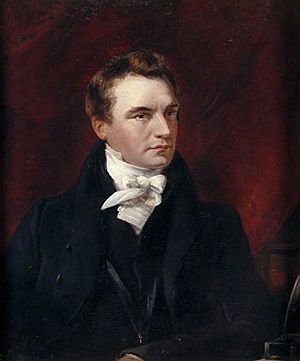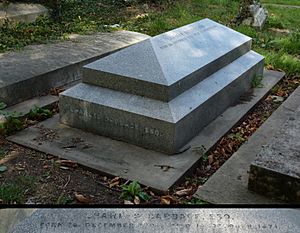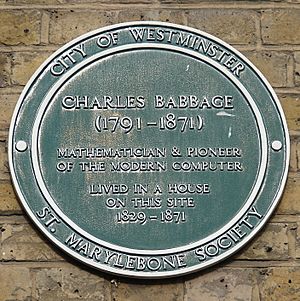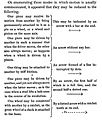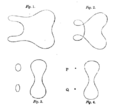Charles Babbage facts for kids
Quick facts for kids
Charles Babbage
KH FRS
|
|
|---|---|
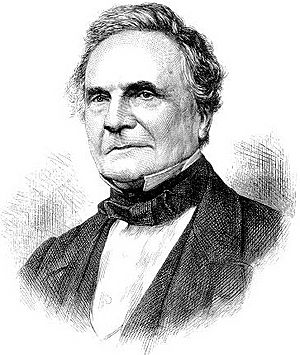
Charles Babbage
|
|
| Born | 26 December 1791 London (likely Southwark)
|
| Died | 18 October 1871 (aged 79) Marylebone, London, UK
|
| Nationality | English |
| Citizenship | British |
| Alma mater | Peterhouse, Cambridge |
| Known for | Difference engine |
| Signature | |
Sir Charles Babbage (born 26 December 1791 – died 18 October 1871) was an English mathematician, mechanical engineer, and computer scientist. He is often called the "Father of the Computer." This is because he was the first person to come up with the idea of a computer that could be programmed. Some parts of his amazing machines are still on display at the London Science Museum today.
Contents
Early Life and Education
Charles Babbage was probably born in London, England, on December 26, 1791. He was one of four children. His father, Benjamin Babbage, was a banking partner.
When he was about eight years old, Charles got a serious fever. He was sent to a country school to get better. For a short time, he went to King Edward VI Grammar School. But his health meant he had to study with private teachers instead.
Later, Babbage joined Holmwood Academy. This school had a great library, which helped him love mathematics even more. He continued to study with private tutors. One of them helped him prepare for Cambridge University.
In October 1810, Babbage started at Trinity College, Cambridge. He had already taught himself a lot about math. He was quite disappointed with the math lessons at the university.
In 1812, Babbage, John Herschel, George Peacock, and other friends started the Analytical Society. They wanted to improve how math was taught in England.
Babbage then moved to Peterhouse, Cambridge. He was the best math student there, but he didn't graduate with special honors.
Career and Inventions
Babbage quickly became well-known for his ideas. He gave talks about astronomy in 1815. In 1816, he became a member of the Royal Society, a famous group of scientists.
After university, Babbage relied on his father for money. In 1814, he married Georgiana Whitmore. They lived in London and had a large family. When his father died in 1827, Babbage inherited a lot of money. This made him very wealthy. After his wife died in the same year, he traveled for a while.
Babbage helped create the Royal Astronomical Society in 1820. This group wanted to make astronomical calculations easier and more accurate. This goal was very similar to Babbage's ideas about machines that could calculate. In 1824, he won the group's Gold Medal. He won it for inventing a machine to calculate math and astronomy tables.
Babbage worked on many scientific and engineering ideas. But he is most famous for two machines that he started but never fully finished. His Difference Engine would have been a much better calculator than anything made before. His Analytical Engine would have been the first true computer.
Babbage knew that human-made math tables often had many errors. He wanted to find a way to calculate them using machines. This would remove human mistakes. He was influenced by his dislike of errors, his work with math tables, and earlier calculating machines. He first shared his ideas for a calculating machine in 1822.
Babbage's engines were some of the first mechanical computers. They were never fully built because he didn't have enough money. Babbage realized that machines could do work better and more reliably than people. His machines were large and powered by steam. They were designed in a way similar to modern computer architecture. This means they had separate parts for data and programs. They followed instructions, could make choices, and had input/output parts. Ada Lovelace studied how to program these machines.
In 1832, Babbage wrote a book called On the Economy of Machinery and Manufactures. It was about how to organize factories and production. In this book, Babbage described what is now called the "Babbage principle." This idea says that if you divide work among different people, you can save money. For example, skilled workers might spend time on simple tasks. If you give simple tasks to lower-paid workers, you can cut costs.
In 1838, Babbage invented the pilot, also known as a cow-catcher. This is the metal frame on the front of trains that clears obstacles from the tracks. He also built a machine to measure the power of engines.
Babbage also invented an ophthalmoscope. This is a device used to look inside the eye. However, it wasn't used much until someone else invented it again later.
Babbage also made important discoveries in cryptography, which is the study of secret codes. But his work in this area was not known until many years after he died.
Family Life
On July 25, 1814, Babbage married Georgiana Whitmore. They lived in London.
Charles and Georgiana had eight children. Sadly, only four of them lived past childhood. These were Benjamin Herschel, Georgiana Whitmore, Dugald Bromhead, and Henry Prevost. Charles's wife, Georgiana, died in 1827. In the same year, his father and two of his young sons also passed away.
His youngest son who survived, Henry Prevost Babbage (1824–1918), later built six small working models of his father's Difference Engine. One of these was sent to Harvard University. Henry Prevost's Analytical Engine Mill, built in 1910, is now on display at the Science Museum.
Death and Legacy
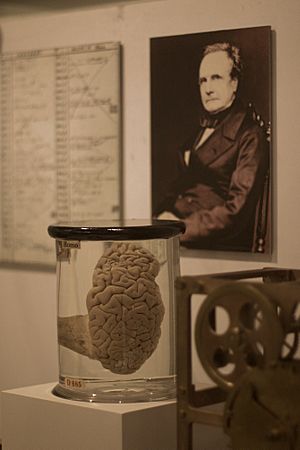
Babbage lived and worked for over 40 years at 1 Dorset Street in London. He died there on October 18, 1871, at the age of 79. He was buried in London's Kensal Green Cemetery. He had turned down offers to become a knight or a baronet.
Autopsy Report
In 1983, Charles Babbage's autopsy report was found and published by his great-great-grandson. Half of Babbage's brain is kept at the Hunterian Museum in London. The other half is on display at the Science Museum, London.
Memorials
There is a special black plaque in London that remembers the 40 years Babbage spent at 1 Dorset Street. Many places and things are named after him, including:
- The Moon crater Babbage
- The Charles Babbage Institute, a research center for information technology
- The Charles Babbage Premium, an annual award for computing
- British Rail named a train after him in the 1990s
- The Babbage Building at the University of Plymouth, where the computer school is located
- The Babbage programming language
- "Babbage", The Economist's Science and Technology blog
- The former computer and video game store "Babbage's" (now GameStop) was named after him.
See also
 In Spanish: Charles Babbage para niños
In Spanish: Charles Babbage para niños
Images for kids
-
Part of Charles Babbage's Difference Engine (#1). His son, Henry Prevost Babbage, put it together after his father's death. It's at the Whipple Museum of the History of Science, Cambridge, England.
-
A part of the Analytical Engine on display in 1843, shown in this old drawing of the King George III Museum in King's College, London.


